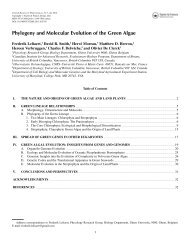DICTYOTALES, PHAEOPHYCEAE - Phycology Research Group ...
DICTYOTALES, PHAEOPHYCEAE - Phycology Research Group ...
DICTYOTALES, PHAEOPHYCEAE - Phycology Research Group ...
You also want an ePaper? Increase the reach of your titles
YUMPU automatically turns print PDFs into web optimized ePapers that Google loves.
1284OLIVIER DE CLERCK ET AL.ally larger than 200 mm in diameter and often spread tobecome confluent with neighboring sori, whereas theyare smaller than 200 mm and remain discrete in D.crispata and D. magneana (De Clerck 2003).Male reproductive structures have not been observedwith certainty in D. cervicornis. Abbott and Huisman(2004) reported multicellular paraphyses for D.acutiloba J. Agardh from the Hawaiian Islands andcommented on the similarity of that species with D.cervicornis, stating that both species ‘‘share all majorcharacteristics.’’ Conspecificity of these taxa is, however,negated by our molecular phylogeny in whichboth species are positioned in completely differentclades. A possible explanation could be that the maleplant depicted by Abbott and Huisman is in fact representativeof D. cervicornis, the presence of which hasgone unnoticed in Hawaii due to its striking habit resemblanceto D. acutiloba. The D. cervicornis–crispataclade is further characterized by the presence of a conspicuousinvolucrum surrounding the sporangia. Suchan involucrum consists of a collar of inflated and radiallyelongated cortical cells and was first noticed byJaasund (1970). In transverse section, this results in awell-developed cup surrounding the basal part of thesporangium. Although the involucrum may go unnoticedin mature sporangia when viewed from thethallus surface, once the spores have been released aclear collar of involucral cells becomes evident (Coppejanset al. 2001: pl. 1F–H). In D. radicans and D.suhrii (De Clerck 2003), as well as in some species ofDilophus studied by Phillips (1992, e.g. Dil. fastigiatusand Dil. robustus), the cortical cells in the immediatevicinity of the sporangium may elongate somewhat,but the resulting involucrum always remains inconspicuous.The species possessing inconspicuous involucres areperhaps better characterized by the number of stalkcells subtending their sporangia. A sporangial stalk cellis formed in most Dictyotales apart from Lobophora andZonaria (Phillips and Clayton 1997). Ontogenetically, astalk cell is formed in the early stages of sporogenesisby a mitotic division of an enlarged cortical cell thatresults in a basal stalk cell and a distal tetrasporemother cell (Williams 1904, Kumagae et al. 1960).Phillips (1992) was the first to appreciate the taxonomicsignificance of sporangia subtended by multicellularstalks, which were initially reported for Dil. fastigiatus,Dil. marginatus, and Dil. robustus. Later, the presence oftwo-celled stalks was also reported for D. radicans andDil. suhrii (De Clerck 2003). Based on the molecularphylogeny, it seems most likely that this characterevolved independently on two occasions in the Dictyoteae,once in Dil. fastigiatus and once in the D. radicans,Dil. marginatus, and Dil. suhrii clade. In combinationwith involucral morphology, however, this points to aclear anatomical discrimination of the D. radicans–Dil.marginatus–Dil. suhrii clade on the one hand versus Dil.fastigiatus on the other. In the first clade, all species arealso morphologically characterized by undulatingthalli, whereas the fronds of Dil. fastigiatus are complanateand smooth. The rugose thallus surface of Dil.robustus, also characterized by two sporangial stalk cellsbut due to lack of suitable material not included in theanalyses, could possibly be interpreted as derived froman undulating thallus.Taxonomic conclusions. The molecular and morphologicalresults presented leave little doubt that thecurrent generic classification of the Dictyoteae doesnot reflect the evolutionary history of the tribe. Thisincongruence between the molecular phylogeny andthe current classification could form the impetus for avery broad interpretation of the genus Dictyota thatwould include all species characterized by a singletransversely oriented apical cell regardless of differencesrelated to vegetative or reproductive structures.On the other hand, one may argue that threeor four separate genera are warranted. Based on thefacts that the molecular phylogeny is well resolved(and alternative topologies strongly rejected) andthat diagnostic vegetative and reproductive criteriaare available, we opt for a somewhat less than totallyinclusive definition of Dictyota and the description oftwo new genera (described below) based on molecularand morphological data. The taxonomic positionof the genus Dilophus is left undecided at this stage,because material of Dil. gunnianus (the generitype ofDilophus) suitable for DNA extraction was not availableand also because of the phylogenetic position ofDil. fastigiatus. The latter occupies a position sister tothe large Dictyota–Dilophus–Glossophora–Glossophorella–Pachydictyon clade and is differentiated from thelarger clade by the presence of two rather than onestalk cells. Dil. gunnianus and Dil. fastigiatus are morphologicallysimilar to such an extent that less typicalgrowth forms are hard to assign to one species or theother. The number of sporangial stalk cells does,however, differentiate both species unequivocally,Dil. gunnianus being characterized by a single stalkcell (Phillips 1992). Extrapolating from the morphologicalobservations, one would expect Dil. gunnianusto be resolved within the Dictyota–Dilophus–Glossophora–Glossophorella–Pachydictyonclade. In the absenceof sequence data for the type species however, onecannot rule out a close relationship between Dil.fastigiatus, Dil. gunnianus, andDil. robustus, and hencethe taxonomic conservatism that we adopt forthe moment still regards Dilophus as a valid genus.The emended description of Dictyota and diagnosesof the new genera Canistrocarpus and Rugulopteryx areas follows:Dictyota Lamouroux, J. Bot. (Desvaux) 2: 38 (1809)nom. cons.Thallus flattened, ribbon-like, erect or prostrate,with smooth, dentate, crenulate or ciliate margins;attachment by basal rhizoids or marginal rhizoidalprocesses scattered along the edges of the thallus orrestricted to the base, stoloniferous holdfasts presentor absent; branching dichotomous, anisotomous oralternate, rarely falcate; apices obtuse, rounded, apiculateor acute; phaeophycean hairs and superficial
















